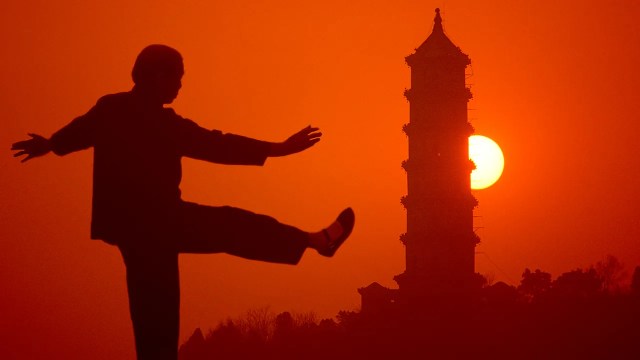
It is unclear whether there has been any significant change since 2010 in the percentage of Chinese adults who identify with a religion or engage in religious beliefs or practices.
Some scholars have relied on a mix of fieldwork studies, claims by religious organizations, journalists’ observations and government statistics to suggest that China is experiencing a surge of religion and is perhaps even on a path to having a Christian majority by 2050.
However, more than a decade’s worth of data from the Chinese General Social Survey (CGSS), the World Values Survey (WVS) and other large-scale surveys provides no clear confirmation of rising levels of religious identity in China, at least not as embodied by formal zongjiao (宗教) affiliation and worship attendance.
Changes in traditional beliefs and practices beyond zongjiao are difficult to quantify, due to a lack of comparable measures over time. Although several Chinese surveys have included questions about traditional beliefs and practices at least once, their wording and/or methodology have changed from wave to wave. As a result, these surveys cannot reliably measure change over time in traditional beliefs and practices.
In short, this report finds no empirical survey evidence that China has experienced a surge in religion since 2010 – but also cannot firmly rule it out, given the many sources of uncertainty.
Zongjiao measures
Overall, survey measures on zongjiao identity and practice, which capture a narrow and relatively formal range of religious engagement, have generally been stable since 2010, and in some cases seem to have decreased. According to the CGSS, 12% of Chinese adults claimed a religious affiliation (zongjiao xinyang 宗教信仰) in 2010. While this may seem slightly higher than the 10% who claimed a religious affiliation in 2018, the difference is within the margin of sampling error and is not statistically significant.
More recently, the 2021 CGSS found 7% of respondents identified with any religion. However, the 2021 wave covered fewer provinces and therefore may not be directly comparable with earlier waves.6
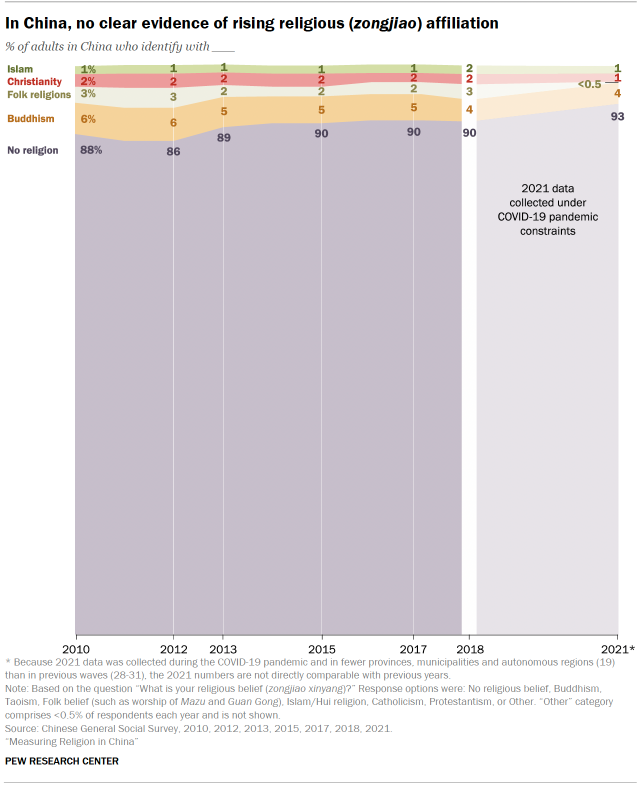
The CGSS does not show a significant increase in the shares of self-identified Catholics, Muslims, Protestants or Taoists during this period, and it indicates that the share of Chinese adults who formally identify with Buddhism dropped slightly.7
Meanwhile, fewer Chinese adults reported attending religious (zongjiao) activities. In 2012, 11% of respondents said they attended religious activities at least a few times a year. By 2018, 6% said they did so, a decline that is statistically significant. In the 2021 CGSS, just 3% of respondents reported attending zongjiao activities – though the 2021 figure may have been affected by a combination of COVID-19 pandemic restrictions and more sporadic sampling in China’s various regions.
What about the roughly one-in-ten respondents who claim a religious affiliation? Has their level of religious activity increased? The available data suggest the answer is “no.” The share of religiously affiliated Chinese adults who say they attend religious (zongjiao) activities at least a few times a year dropped from 53% in 2012 to 45% in 2018. In 2021, just 35% of religiously affiliated Chinese adults reported attending religious activities at least a few times a year – though, again, 2021 could be an anomalous year because of the pandemic.
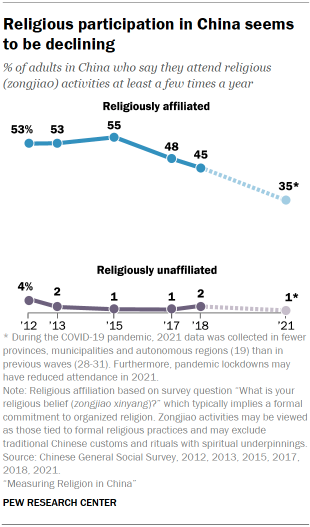
Between early 2020, when the coronavirus broke out in Wuhan, China, and the end of 2022, when the Chinese government reopened the country, all places of worship in China experienced temporary or long-term shutdowns as part of the central government’s “zero-COVID” policy.
Initially, in early 2020, all religious sites in China were closed, and gatherings were banned in an effort to contain the virus. Later that year, many sites reopened after the outbreaks in their local areas had subsided, but some sites remained closed. And some that reopened were subsequently shut down again due to fresh outbreaks or rebounding cases of COVID-19.
During the pandemic, some Chinese people engaged remotely in religious activities, such as virtually venerating ancestors on Tomb Sweeping Day (also known as the Qingming Festival) and attending Taoist services online. But it is unclear how virtual participation in zongjiao activities may have affected the way respondents answered the zongjiao attendance question in the 2021 CGSS.
Differences by age
An analysis of age patterns in the 2018 CGSS paints a mixed picture. For example, young adults are slightly less likely than older Chinese people to say they attend zongjiao activities. About 5% of Chinese adults under 35 in 2018 said they attend zongjiao activities a few times a year or more, compared with 8% of those ages 55 and above.
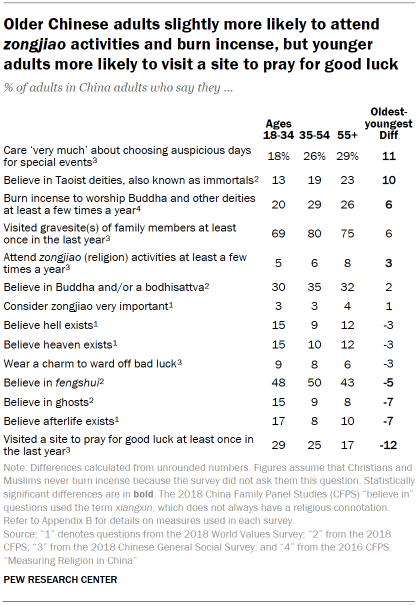
Surveys also indicate that younger adults are less likely than those ages 55 and older to care “very much” about choosing auspicious days for special occasions (18% vs. 29%), according to the 2018 CGSS. And younger adults are less likely to burn incense to worship Buddha and other deities, according to the 2016 China Family Panel Studies (CFPS) survey.
However, some folk religious beliefs and practices are more common among young Chinese adults than among their elders.
For example, 29% of adults under 35 reported in the 2018 CGSS that they had visited a place – typically a shrine or temple – to pray for good fortune in school, health or business in the past year, compared with 17% of those ages 55 and older. Adults under 35 also are somewhat more likely than older Chinese to believe in ghosts and in fengshui (风水), the 2018 CFPS finds.
There is no clear pattern by age group on several other measures, such as belief in Buddha and/or a bodhisattva or belief in heaven or hell.
(For more on how Chinese survey respondents may interpret these questions, read the discussion of Chinese religious traditions in Chapter 2.)
Official numbers of worship sites and personnel
Government figures on places of worship, as well as data on tourism at religious heritage sites, generally rose for traditional Chinese religions between 2009 and 2018. By contrast, the numbers of officially registered Protestant and Catholic churches and Islamic mosques remained virtually unchanged.
Meanwhile, the numbers of officially registered religious personnel have followed different trajectories, with some religious groups (such as Buddhist monks and nuns) experiencing increases and others (such as Taoist clergy) facing declines.
In this report, government statistics refer to data and estimates published by the Chinese government, the Chinese Communist Party, state-controlled agencies (such as the Buddhist Association of China) and organizations that are directly supervised by the State Council of China (such as the Chinese Academy of Social Sciences). However, little information is available about the methods used to produce such statistics. In some cases, there may be reason to doubt their reliability or completeness.
According to China’s State Council Information Office (SCIO), the total number of religious sites registered with the five official religious associations increased by 11%, from about 130,000 in 2009 to 144,000 in 2018, largely due to a surge in Buddhist and Taoist temples. The overall increase in worship sites outpaced Chinese population growth of around 6% during that time.
The SCIO does not track folk religion venues, as there is no supervisory religious association for folk belief. But data from several Chinese provinces that publish regional counts of folk religion temples indicates that these far outnumber the total number of registered worship sites.8 (For more about worship sites tied to traditional Chinese religions, read “How many Buddhist, Taoist, Confucian and folk religious sites are there in China?”)
While the SCIO’s count of religious venues is the most comprehensive dataset available, it has limitations: The figures do not include unregistered or unauthorized sites, and some authorized religious sites also appear to be missing. One possible explanation for this inconsistency is that the Chinese words for “register” – dengji (登记) or zhuce (注册) – are ambiguous. They can mean either “put on local government record” or “granted formal registration.” When local authorities report that they have “registered” a site, it is not always clear which of those two events has occurred.
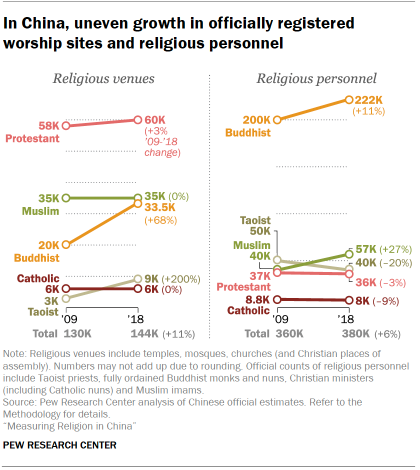
Because local authorities across China have intensified their efforts since 2017 to absorb unauthorized places of worship into the official system (banning unauthorized churches that refuse to join the state-controlled associations), one might have expected to see an increase in the number of authorized Christian worship sites in recent years.9
However, government figures show no growth in the numbers of formally registered Protestant and Catholic sites between 2009 and 2018, the latest year for which official figures are available.
The next section presents government data on Taoist and Buddhist religious sites and personnel. Parallel discussions for other religions can be found in the Christianity chapter and the folk religion section.
Taoist and Buddhist worship sites and clergy
The number of officially registered Taoist temples tripled from 3,000 in 2009 to 9,000 in 2018, according to the SCIO.10 The number of officially registered Buddhist temples rose by about 68% during that time, from 20,000 to 33,500.
There is some evidence that most or all of this growth took place in the early part of that period.11 In 2012, the director of the National Religious Affairs Administration (formerly the State Administration for Religious Affairs), Wang Zuoan, shared numbers of Buddhist and Taoist temples that were identical to those released by SCIO in 2018, and the same figures were published again by People’s Daily, the Chinese Communist Party’s official newspaper.12
The increase in the number of registered temples associated with traditional Chinese religions was due, at least in part, to preferential government treatment. In the early 2010s, state and local authorities – eager to boost their local economies and cultural pride by promoting religious tourism – often permitted and even encouraged the construction or renovation of Buddhist, Taoist and folk religion temples.
By 2012, religious venues – which are mostly Buddhist and Taoist – reportedly accounted for nearly half the country’s top-rated (or 5A-rated) tourist sites.13
However, the surge in temple construction and registrations did not last, as the government in 2012 started to crack down on developers who built temples or erected Buddha statues to earn profits from religious tourism. Following guidelines to combat what authorities described as “the commercialization of Buddhism and Taoism,” local authorities began tearing down large, outdoor Buddha statues in unauthorized temples and terminating the construction of unregistered temples. In 2017, the state intensified these efforts, banning any commercially oriented temple construction altogether.
In addition, the number of Taoist and Buddhist clergy did not keep pace with the increase in temples between 2009 and 2018. Taoist clergy dropped by about 20% during this time to 40,000, while Buddhist clergy rose by around 11% to 222,000, according to the SCIO. (Taoist clergy include Taoist priests as well as monks and nuns who have gone through the ritual of ordination; Buddhist clergy refer only to fully ordained monks and nuns.)
These different trajectories may have multiple causes, including that new temples meant to serve tourists may require fewer religious personnel. Meanwhile, as China’s economy has expanded and more people move to cities, monastic life seems to be gradually losing appeal. Even at-home Taoist priests (huoju daoshi 火居道士) may find it difficult to continue the tradition of passing down clergy positions from generation to generation.
In addition, the government’s ban on religious education for children and a law requiring all children to attend schools for a minimum of nine years have added extra challenges for religious groups that largely rely on monastic education to train monks and nuns.
Religious tourism
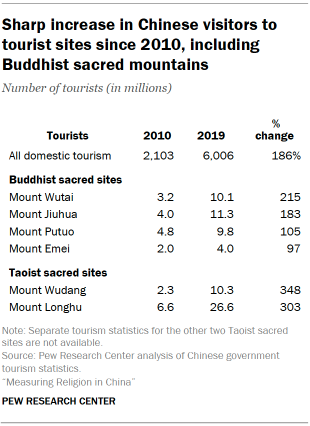
Government data indicates that tourist destinations featuring religion, such as Mount Jiuhua, a Buddhist sacred site, and Mount Wudang, a Taoist holy place with around 200 temples, experienced large increases in visitors between 2010 and 2019.
These gains correspond with an overall boom in domestic tourism in China. In the decade before the coronavirus outbreak, the annual number of domestic tourist visits nearly tripled, from 2.1 billion in 2010 to 6.0 billion in 2019, according to China’s Ministry of Culture and Tourism.
While visitors who travel to religious sites are not necessarily pilgrims, many engage in religious activities at temples and shrines, such as praying for good fortune.14 A study of tourists to Hanshan Temple found that fewer than one-in-six said they visited just for sightseeing, while about half said they had multiple reasons for the trip, including sightseeing, praying for good fortune and engaging with Buddhist history.
A different survey, conducted in 2014, found that about 17% of visitors to Mount Wudang described their trip as a pilgrimage, although fewer than 3% identified as Taoist.




